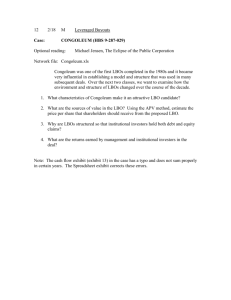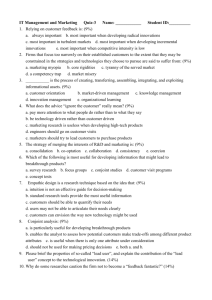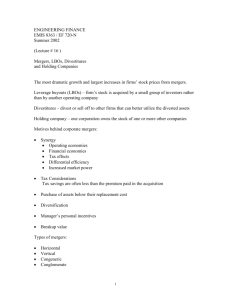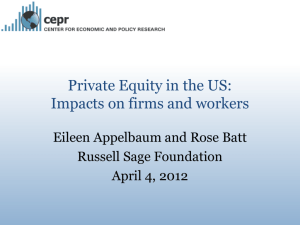Le_Nadan_Perdreau
advertisement
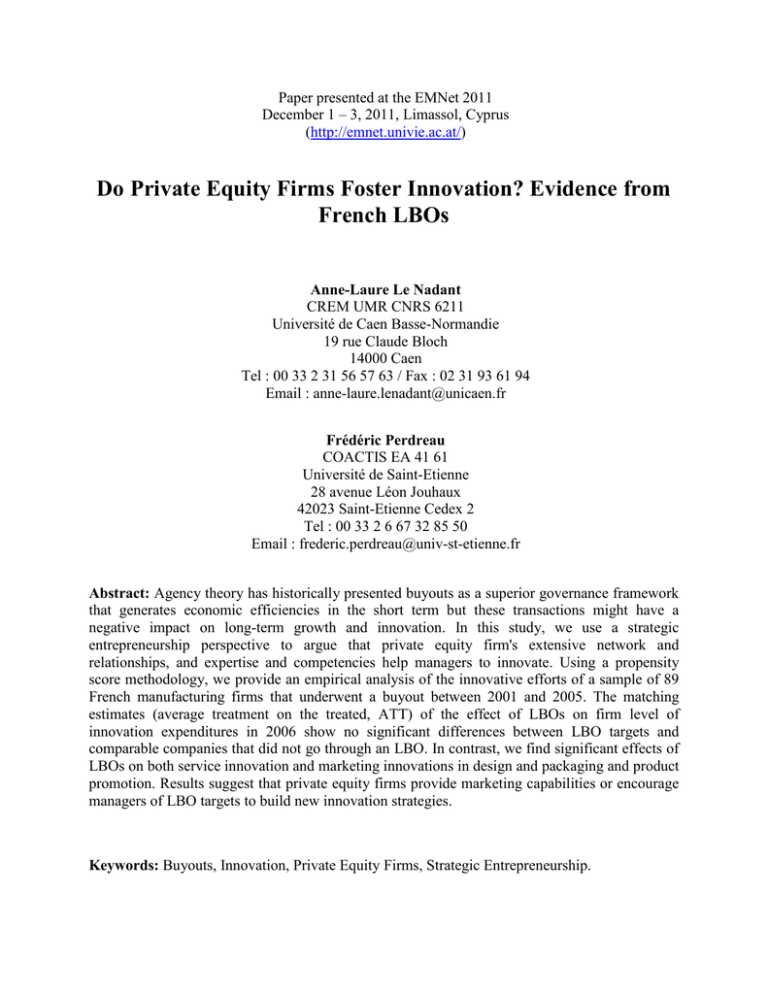
Paper presented at the EMNet 2011 December 1 – 3, 2011, Limassol, Cyprus (http://emnet.univie.ac.at/) Do Private Equity Firms Foster Innovation? Evidence from French LBOs Anne-Laure Le Nadant CREM UMR CNRS 6211 Université de Caen Basse-Normandie 19 rue Claude Bloch 14000 Caen Tel : 00 33 2 31 56 57 63 / Fax : 02 31 93 61 94 Email : anne-laure.lenadant@unicaen.fr Frédéric Perdreau COACTIS EA 41 61 Université de Saint-Etienne 28 avenue Léon Jouhaux 42023 Saint-Etienne Cedex 2 Tel : 00 33 2 6 67 32 85 50 Email : frederic.perdreau@univ-st-etienne.fr Abstract: Agency theory has historically presented buyouts as a superior governance framework that generates economic efficiencies in the short term but these transactions might have a negative impact on long-term growth and innovation. In this study, we use a strategic entrepreneurship perspective to argue that private equity firm's extensive network and relationships, and expertise and competencies help managers to innovate. Using a propensity score methodology, we provide an empirical analysis of the innovative efforts of a sample of 89 French manufacturing firms that underwent a buyout between 2001 and 2005. The matching estimates (average treatment on the treated, ATT) of the effect of LBOs on firm level of innovation expenditures in 2006 show no significant differences between LBO targets and comparable companies that did not go through an LBO. In contrast, we find significant effects of LBOs on both service innovation and marketing innovations in design and packaging and product promotion. Results suggest that private equity firms provide marketing capabilities or encourage managers of LBO targets to build new innovation strategies. Keywords: Buyouts, Innovation, Private Equity Firms, Strategic Entrepreneurship. 1. Introduction Innovation is an essential preoccupation for a firm as it affects its competitiveness. Agency theory has traditionally presented buyouts as a superior governance framework that generates economic efficiencies in the short term but LBO funds, driven by short-term profit motives, might sacrifice long-term growth and innovation to boost short-term performance. LBOs involve investments in which investors and a management team pool their own money (together with debt finance) to buy shares in a target company from its current owners (Meuleman et al., 2009). Although the change in governance resulting from LBOs is generally found to exert a positive impact on firm’s economic and financial performance (Cumming et al., 2007), these transactions have mainly been associated with cost-cutting activities and shorttermism, to the detriment of innovation and Research and Development (R&D) investments. However, in a recent study, Boucly et al. (2011) show that, instead of reinforcing credit constraints, as was the case in the 1980s transactions, today’s LBOs can alleviate them. Whether LBOs have an impact on innovation is not clear, a priori. Both positive and negative effects are likely to occur. From the agency theory perspective, after an LBO, technological matters may be delayed or set aside because managers may be more oriented to day to day operations resulting from the transaction (Hitt et al., 1996) or because private equity firms exert pressure on management to focus on investment opportunities that are less uncertain and more rewarding in the short term (Ughetto, 2010). Alternatively, from the strategic entrepreneurship perspective, LBOs may foster entrepreneurial initiatives, enabling managers to better and more thoroughly exploit firm resources for new innovation projects (Wright, Hoskisson and Busenitz, 2001). Innovation requires the entrepreneurial capabilities of opportunity recognition and opportunity exploitation (Withers et al., 2011). The private equity firm's expertise and competencies with regard to strategy, operational and financial management, human resources, marketing policy, and mergers and acquisitions help identify an opportunity for innovation and create value for the target firm (Lee et al., 2001; Wright, Hoskisson, Busenitz, and Dial, 2001). Private equity-backed buyouts can also make use of the private equity firm's extensive network and relationships (customers, suppliers, other investors, access to more sophisticated resources in banking, and legal and other areas) to leverage their capabilities for innovation. In particular, private equity firms’ networks may put them in a position to provide resources and capabilities the management of the buyout firm is currently missing (Meuleman et al., 2009). Moreover, inside management does not always own the tacit knowledge and idiosyncratic skills required to seize new opportunities (Hendry, 2002). If major innovation is required, it may be necessary to introduce outside managers who do own these skills (Wright, Hoskisson, and Busenitz, 2001). In this situation, the private equity firm plays an important role in assessing the skills of the incumbent managers and their potential replacements (Meuleman et al., 2009). Evidence regarding the impact of LBOs on investment in innovation and R&D is so far limited and rather mixed. Some studies show a decline in R&D spending (Long and Ravenscraft, 1993) whereas others find no decline (Lichtenberg and Siegel, 1990) or stability (Smith, 1990) of 2 research spending after the LBO. However, as most firms involved in LBOs do not belong to technology-intensive industries, the impact of LBOs on cumulative innovation is likely slight (Hall, 1990). In industries where R&D requirements are more crucial, these expenditures are used more effectively. Zahra (1995) finds, on a sample of 47 LBOs, that firms involved develop more new products and intensify their efforts in terms of innovation and productivity (even if at the same time the level of R&D expenditure doesn’t change). Wright et al. (2001) provide several examples of buyouts in technology-based industries followed by significant increases in product and technology development, R&D and patenting. Malone (1989) and Wright, Thompson and Robbie (1992) also cite evidence of new product innovation following buyouts. More recently, Lerner et al. (2011) investigate 472 LBOs with a focus on investments in innovation as measured by patenting activity. They find no evidence that LBOs are associated with a decrease in these activities. Contrary to the frequent argument that private equity firms have short-term horizon and little incentive to favor long-term investment opportunities of target companies, this study shows that LBOs lead in fact to significant increases in long-term innovation. The authors find that patents granted to firms involved in LBOs are more cited (a proxy for economic importance) and show no significant shifts in the fundamental nature of the research. Hence, if some US and UK based studies show a decline in investment expenditure after LBOs, critical investments in R&D seem to be maintained. Ughetto (2010) has focused on innovation of Western European manufacturing firms undergoing an LBO. She finds that innovation activity of portfolio firms (measured by the number of patents granted) is affected by different types of investors, pursuing different objectives. Through this study, we seek to contribute to the entrepreneurship and strategic management literatures on innovation and networks in several ways. First, we revisit the questions in the previous studies because the private equity industry is more substantial today than it was in the 1980s. Changes in the industry–such as the increased competition between and greater operational orientation of private equity firms–suggest that the earlier relationships may no longer hold. In addition, transactions involving technology-intensive industries have become more common recently and it is also desirable to look beyond public-to-private transactions, since these transactions represent a fairly small fraction of the private equity universe. Second, we contribute by using an innovation survey that has never been used to analyze buyouts. This survey substantially enhances our ability to measure and study the impact on innovation. Third, nearly all studies on LBOs and innovation have concentrated on the US and the UK (the only exception we are aware of is the study of Western Europe by Ughetto (2010)). By shifting the focus to France and following Boucly et al. (2011), this study investigates the possibility that some LBOs aim to seize innovation opportunities and expand the scale and scope of the target’s activities. France is an interesting context to study LBOs and innovation because it is a country with many family-managed firms that tend to be, on average, smaller than non family firms and for which access to external finance may be more difficult than in the US or the UK. The remainder of the paper is as follows. In Section 2, we describe the construction of the sample. Section 3 reviews the methodology employed in the study. We present the empirical analyses in Section 4. The final section concludes the paper and discusses future work. 3 2. Dataset To analyze the impact of LBOs on innovation at the company level, we use a new database built from three different databases: Capital IQ (to isolate transactions), CIS 2006 (for innovation data) and DIANE (for financial statements). To our knowledge, this is the first study to use a CIS survey (Community Innovation Survey) in relation with LBOs. Community Innovation Surveys are conducted at regular intervals in Europe. Questions are based on the Oslo Manual guidelines, which distinguishes four types of innovations: product innovations, process innovations, organizational innovations and marketing innovations. The Oslo Manual opted for collecting data at the firm level, including all its innovation outputs and activities, which is also the level of available accounting and financial data that can be merged with the innovation data for richer analyses. CIS 2006 was launched in 2007, based on the reference period 2006, with the observation period 2004 to 2006. The population of the CIS is determined by the size of the enterprise and its principal activity. All enterprises with 20 or more employees in any of the specified sectors were included in the statistical population. The following industries were included in the population of the CIS 2006: mining and quarrying (NACE 10-14), manufacturing (NACE 15-37), electricity, gas and water supply (NACE 40-41). Three reference periods were used in the questionnaire: The first relates to a set of questions for the whole of the period 2004-2006, for example whether the enterprise introduced an innovation at any time during this three-year period. The second set of questions refers uniquely to the reference year 2006, for example, indicators such as innovation expenditure. Finally, a limited number of basic economic indicators were requested for both 2004 and 2006, for example the turnover and employment figures. We first identify 944 French deals over 2001-2005 reported as being “LBOs” from Capital IQ. More precisely, we retrieve all the deals from Capital IQ with the following characteristics: (i) they are announced between 2001 and 2005 (ii) either “closed” or “effective” (iii) reported by Capital IQ as being “LBOs”. Most of the targets are medium sized, privately held firms. We then obtain innovation data from CIS 2006. Our transaction and innovation data do not have the same identifier so we match them by company name. Names are not always identical in both databases, so in case of ambiguity we resort to company websites and annual reports. The matching process reduces sample size to 109 transactions, of which 89 have available financial statements in Diane (Bureau Van Dijk) for the year preceding the transaction. Table 1 summarizes the characteristics of the final sample. 47% of deals take place since 2004. Slightly less than 40% of the sample is composed of companies in intermediate goods (52% in terms of value of the deals). In terms of size, the sample is mostly constituted of relatively small companies: 34% of targets have less than 20 million (M) Euros in sales at the time of the deal, and 69% have less than 75M. Companies with sales above 75M constitute 31% of number but 74% of the value of deals. 4 Table 1 – Descriptive statistics of final sample This table shows the number and value of deals in the sample. Value is measured using the sum of sales revenue of companies in each category, in thousands of Euros, for the year prior to the deal. Breakdown by sector follows the French classification named NES16 (Nomenclature Economique de Synthèse). Panel A : Breakdown by year 2001 2002 2003 2004 2005 Number 18 12 17 22 20 Total 89 % 20.22% 13.48% 19.10% 24.72% 22.47% Value 1 099 628 1 000 782 1 139 305 1 162 113 1 364 967 % 19.07% 17.35% 19.76% 20.15% 23.67% 5 766 795 Panel B : Breakdown by Sector Agricultural and food industries Consumer Goods Industry Automotive Industry Capital goods industries Intermediate goods Energy Number 7 13 6 24 35 4 Total Panel C : Sample Breakdown by Sales revenues (Sales in Thousand of Euros) (0;20000] (20000;75000] (75000;150000] (150000; max] % 7.87% 14.61% 6.74% 26.97% 39.33% 4.49% 89 Number 31 30 18 10 Total 89 Value 511 133 596 591 241 696 1 232 990 3 019 754 164 630 % 8.86% 10.35% 4.19% 21.38% 52.36% 2.85% 5 766 795 % 34.83% 33.71% 20.22% 11.24% Value 303046 1201816 1762976 2498958 % 5.26% 20.84% 30.57% 43.33% 5 766 795 3. Methodology Gauging effects of LBOs on innovation is not trivial because LBOs do not occur randomly across the population of firms. LBO targets are selected by investors presumably because of their value creation potential. If an outside observer concludes that the average level of innovation expenditure of firms targeted by an LBO is higher than in other firms, one cannot rule out the possibility that this finding is due to the fact that LBO investors tend to select better firms on average relative to the population. We address the problem of sample selection bias using a propensity score methodology (PSM) (Rubin, 1974; Heckman et al., 1999). We benchmark the level of innovation of LBO firms by selecting appropriate matching control firms to each LBO. The set of matching control firms is composed of firms that share the same financial characteristics as the LBO firm prior to the transaction. To select matching firms that have ex-ante the same probability of being selected by LBO investors, we implement a probit model to estimate the likelihood of being an LBO target in 5 a given year and we use the use the probability estimate from that model to find a matching control for a firm that indeed was the target of an LBO deal1. The main steps of the PSM procedure are as follows. First, we introduce filters to obtain a dataset composed of about 1,200 companies. We need to do this because fitting a discrete choice regression model where the number of ‘zeros’ (that is, observations where the firm is not an LBO target in a given year) is very high relative to the number of ‘ones’ (that is, observations where the firm is an LBO target in a given year) results in poor estimates. This is the case since CIS 2006 contains data for about 5,200 companies, and the sample contains 89 LBOs (2 % of the dataset). We therefore introduce filters to obtain a manageable number of non-LBO observations. A matching company belongs to the same 4-digit sector as the target. If there are more than ten twins, we just keep the ten nearest neighbors to the target with the nearest turnover the year preceding the buyout. The matching methodology allows us to retain 1,144 “twin” companies to the sample, i.e. 12.85 twins by target. We choose 1,200 as a number that seems reasonable because it means that LBOs constitute about 8% of the regression sample. Second, we run a probit regression that models the likelihood of a firm being the target of an LBO in a particular year. Denote by hk* the latent unobservable variable that represents the net present value of the acquisition of firm k by a bidder and hk,t a dummy that takes the value of 1 if an LBO bid is made in year t: hk,t = 1 if hk,t* >0 or hk,t = 0 if hk,t* < 0. The probit regression to be estimated for the probability of Pr(hk,t = 1) is: hk,t* = α +Wk,t δ + υk,t (1) The matrix Wk,t contains firm-specific variables that the literature has identified as determinants of the likelihood that a firm is an LBO target, namely firm size (measured by turnover), the debtequity ratio, the level of income taxes, the firm’s profitability (measured by ROIC), liquidity (proxied by cash divided by assets) and level of working capital (Le Nadant and Perdreau, 2006). The predicted value from regression model (1) is called the propensity score. Its interpretation is that it measures the probability, as predicted by the model, that a firm becomes an LBO target in a given year. In other words, firms with similar propensity scores share similar characteristics that lead to being an LBO target. They constitute therefore adequate benchmarks for LBO innovation capacity. Third, we use propensity score to match comparison units with treated units. Smith and Todd (2005) note that measuring the proximity of cases as the absolute difference in the propensity score is not an approach that is robust to “choice-based sampling,” where the treated are oversampled relative to their frequency in the population of eligible individuals (Caliendo and Kopeinig, 2008). As a consequence, we match on the log odds of the propensity score, defined as p/(1-p), to assure that results are invariant to choice-based sampling. Different matching algorithms can be used: kernel matching, nearest-neighbor or radius matching. As we have many firms not involved in LBOs in our dataset, the radius matching 1 For a binary treatment variable, there is no strong advantage to use the logit vs. probit model. We also ran a logit model and found similar results. 6 algorithm (with a caliper of 0.06) is more appropriate: it enables us to compare firms with very close predictions of probit models. To avoid the risk of poor matches, radius matching specifies a “caliper” or maximum propensity score distance by which a match can be made. The basic idea of radius matching is that it uses not only the nearest neighbor within each caliper, but all of the comparison group members within the caliper. In other words, it uses as many comparison cases as are available within the caliper, but not those that are poor matches (based on the specified distance). The robustness of our results is tested using other matching methods. We then measure, for each LBO, its level of innovation relative to the level of innovation of its matching control pair. 4. Post LBO innovation: evidence and robustness a) Main results Table 2 presents summary statistics for accounting measures of LBOs and the non-LBOs firms. Relative to their potential controls, LBO firms are larger (65 M in average turnover vs. 40M) and slightly more profitable (23% vs. 20% in terms of average ROIC), and they have higher income taxes expenses the year before the deal (2.39% of sales for LBO vs. 1.63% for non-LBO). Only differences in size and income taxes expenses are significant (see Appendix 2). 7 Table 2 – Summary statistics This table shows the summary statistics for sample deals for the year before the deal. «LBO companies» refers to statistics of the sample of LBO firms. «Non-LBO companies» refers to statistics of the sample of all non-LBO companies from which matched controls are chosen using a propensity score model. All these accounting variables are obtained from DIANE. Turnover is in thousands of Euros. Income taxes expense and working capital are divided by turnover. Working Capital is divided by net fixed assets. Debt-to-equity is measured by financial debt divided by shareholders’ equity (in %). Non-LBO companies LBO companies Variable Obs. Mean Std. Dev. Min Max Turnover 1144 39566.79 67002.48 10.76 568409.10 ROIC 1144 0.1966 0.6307 -5.0873 13.6855 Income taxes 1144 0.0163 .02335 -0.1314 0.1385 Working capital 1144 0.1936 0.4171 -2.0513 6.4868 liquidity 1144 0.7149 5.0250 0 123.8937 Debt-to-equity 1144 80.92 626.39 -2225.51 13804.17 Turnover 89 64795.45 83478.02 20.13 483000 ROIC 89 0.2259 0.2817 -1.0051 1.0727 Income taxes 89 0.0239 0.0407 -0.1610 0.2417 Working capital 89 0.2173 0.6906 -0.1633 6.4498 liquidity 89 0.3629 0.9031 0 7.5630 Debt-to-equity 89 56.63 216.68 -580.73 1721.00 The results of the probit model show that the largest firms and those that have the highest level of income taxes have a higher probability of being an LBO target (Table 3). In contrast, firms’ financial structure, profitability, liquidity and level of working capital do not seem to explain LBO likelihood. 8 Table 3 – Estimations of the Probit model Turnover is in thousands of Euros. Income taxes and working capital variables are divided by turnover. Liquidity variable is measured by cash and cash equivalents divided by total assets. Debt-to-equity is financial debt divided by shareholders’ equity. Probit regression on 2001-2004 Probit regression on 2001-2005 Indep.variables Turnover ROIC Debt-to-equity Income taxes Liquidity Working capital Constant Coef Std. Error 0.1278*** 0.0427 0.0629 0.1063 -0.0000 0.0001 6.2601*** 2.3278 -0.0103 0.0296 0.0698 0.1245 -3.7741*** 0.7318 Number of Obs. = 1004 (69 LBOs) LR Chi2(6) = 18.31 Prob > Chi2 = 0.005 Pseudo R2 = 0.036 Notes: Significance levels: ***(1%) and **(5%). Coef Std. Error 0.1521*** 0.0389 0.0234 0.1040 -0.0000 0.0001 4.3494** 1.9705 -0.0267 0.0554 0.0744 0.1171 -4.1082*** 0.6705 Number of Obs. = 1233 (89 LBOs) LR Chi2(6) = 23.01 Prob > Chi2 = 0.001 Pseudo R2 = 0.036 Table 4 reports both unmatched and matching estimates (average treatment on the treated, ATT) of the effect of LBOs on firm level of innovation, measured as innovation expenditure in 2006 divided by turnover in 2006. The matching estimates (average treatment on the treated, ATT) of the effect of LBOs on firm level of innovation in 2006 show no significant differences between LBO targets and comparable companies that did not go through an LBO. Moreover, we find no significant effect of LBOs on innovation expenditure at different periods of time (one-year after transaction for LBOs in 2005, two-year after transaction for LBOs in 2004, etc.). Evidence thus suggests that private equity intervention is not detrimental to long-term investments in innovation. 9 Table 4 – Effect of LBOs on the level of innovation expenditure in 2006 Innovation expenditure is measured by all innovation expenditure in 2006 declared by firms as a percentage of turnover the same year. Variable: innovation expenditure Treated Controls Difference S.E. Unmatched 2.8454 2.7256 .1197 .8062 ATT 2.8454 2.7240 .1214 .9560 89 1144 Number of observations Notes: Significance levels: ***(1%), **(5%) and *(10%). Even if LBO targets have the same level of innovation expenditure as their matched counterparts, LBOs might have an effect on other innovation outcomes. Indeed, LBOs might foster entrepreneurial initiatives and innovation projects that are not costly and do not require important expenditure. Table 5 presents PSM estimations on innovation outcomes for LBOs that occurred from 2001 to 2004 (69 LBOs) whereas Appendix 1 presents the innovation outcomes and innovation variables definitions. As questions in CIS 2006 relate to the 2004-2006 period, we exclude 20 LBOs that occurred in 2005 from the sample to run these estimates. The comparison of unmatched and ATT estimates (not reported here) shows the efficiency of the matching method, which significantly reduces the selection bias. Indeed, differences between LBOs and non-LBOs on several outcome variables appear to be significant when they are estimated with unmatched units. For instance, for product innovation (inpdgd) and innovation in external relations (oorgexr), t-statistic values are respectively 1.68 and 1.78 (significant at 10% level) but, after matching, the differences are no longer statistically significant, suggesting that matching helps reduce the bias associated with observable characteristics. Table in Appendix 2 shows the results of the balancing test for the radius model. It confirms the validity of the matching method, which significantly reduces the bias for all covariates. The balancing test measures the “similarity” of observations remaining after the matching process. 10 Table 5 – ATT estimates of innovation outcomes during 2004-2006 Variable type Product innovations Process innovations Organisational innovations Marketing innovations Patents and other protection methods Variable code Treated Controls Difference S.E. inpdgd .5147 .4385 .0761 .0632 inpdsv .2500 .1594 .0905* .0542 newmkt .4264 .3249 .1014 .0623 newfrm .4411 .3237 .1174* .0626 turnmar .0613 .0645 -.0031 .0197 turnin .0544 .0483 .0060 .0172 turnung .8842 .8871 -.0028 .0277 inpspd .3676 .3704 -.0027 .0610 inpslg .1911 .1619 .02918 .0495 inpssu .1764 .1718 .0045 .0482 oorgbup .3823 .3905 -.0081 .0615 oorgkms .2205 .2517 -.0312 .0527 oorgwkp .3088 .3183 -.0095 .0585 oorgexr .2500 .1762 .0737 .0544 mktdgp .3235 .1869 .1365** .0585 mktpdp .2647 .1686 .0960* .0553 mktpdl .1029 .0988 .0040 .0383 mktpri .1617 .1044 .0573 .0461 ProPat .2941 .3245 -.0304 .0577 ProDsg .2352 .1954 .0398 .0534 ProTm .3823 .2847 .0976 .0611 ProCp .1029 .0676 .0353 .0380 prosol .1029 .0666 .0363 .0380 ProSct .1764 .1479 .0285 .0479 ProCon .2647 .2407 .0239 .0557 ProTech .2352 .1776 .0576 .0533 11 Factors hampering innovation activities Number of observations HFent 1.4117 1.2967 .1150 .1331 Hfout 1.0147 .8110 .2036* .1240 Hcos 1.4411 1.2949 .1462 .1431 Hper 1.3970 1.1712 .2258* .1219 Htec 1.0 .8451 .1548 .1044 Hinf 1.0 .8801 .1198 .1112 Hpar .8529 .8068 .0460 .1101 Hdom 1.1029 1.0524 .0504 .1359 Hdem 1.2647 1.1083 .1563 .1299 Hprior .5882 .6676 -.0794 .1136 Hmar .8088 .8727 -.0639 .1325 1,004 69 935 Notes: Significance levels: ***(1%), **(5%) and *(10%). Regarding product and process innovations, we find that LBO targets are more likely to implement service innovations. Hence, results suggest that LBOs lead to significant improvements in how services are provided (for example, in terms of their efficiency or speed), the addition of new functions or characteristics to existing services, or the introduction of entirely new services. However, as we also find an effect on innovations that are new to the firm but no effect on innovations that are new to the market, we can conclude that LBOs lead to minor product innovations that have already been implemented by other firms. Hence, it is likely that the nature of the innovation in LBOs is based upon incrementally improving current products for existing markets rather than developing new products and processes (Zahra and Fescina, 1991). Regarding organisational and marketing innovations, we find significant effects for two variables of marketing innovation only: innovations in design and packaging and in products promotion. Marketing innovations are aimed at better addressing customer needs, opening up new markets, or newly positioning a firm’s product on the market, with the objective of increasing the firm’s turnover. LBOs have a significant effect on changes in product design and packaging that are intended to change or enhance the product’s appeal or to target a new market or market segment. They also have a positive impact on promotional efforts made by firms to improve their products’ image or to increase awareness of their products. This evidence confirms that private equity firms provide superior managerial and technical expertise that enables target firms to seize innovative opportunities. In contrast, we find no effect of LBOs on the methods of protecting innovations. In particular, we show that LBOs have no impact on patenting activity. This result is in line with Lerner et al. (2011). 12 Last, innovation activity may be hampered by a number of factors. There may be reasons for not starting innovation activities at all, or factors that slow innovation activity or have a negative effect on expected results. These include economic factors, such as high costs or lack of demand, and enterprise factors, such as a lack of skilled personnel or knowledge. Regarding obstacles to innovation, results show an effect of LBOs on two factors hampering innovation activities: lack of skilled personnel and lack of external financial resource. These results suggest that LBO targets do not have the skilled personnel needed to engage in innovation activities, or their innovation activities may be slowed because they are unable to find the necessary personnel on the labour market. Moreover, contrary to Boucly et al. (2011) who show that LBOs can alleviate financial constraints and foster growth, our results suggest that LBO targets lack external financial resource for their innovation activities. b) Robustness check We evaluate the robustness of the estimations by changing the matching algorithms. The matching algorithms used are nearest neighbor (with one and three neighbors), radius (with a caliper of 0.06) and kernel. The impact on innovation variables does not appear to depend critically on the algorithm used, since both the value of the coefficients and its significance are very similar using different alternatives. In particular, whatever the algorithm used, we find no impact of LBOs on innovation expenditure and a significant impact on marketing innovation and product innovation that is new only to the firm. 5. Conclusion Hence, although most commentators in the public debate and many financial economists consider LBOs as a way to implement drastic, “cost cutting” measures, this paper provides evidence that ex-post innovation expenditure is similar in LBO targets and comparable firms in France. In addition, we find no evidence that, as for contribution to innovation, LBOs alleviate financial constraints or facilitate business relations. In contrast, we find an effect of LBOs on service innovation but this effect is not related to radical or disruptive innovation as LBOs have an impact on product innovation that is new only to the firm. Moreover, results show that LBO targets are more likely to implement marketing innovations (design and packaging and product promotion) in order to increase turnover and market share. This result is in line with the idea that, following an LBO, management is not only focused on “cost cutting” activities that aim to increase value creation. Private equity firms also encourage managers of LBO targets to build new strategies to find and exploit value creation potentials. Further, these results emphasize the resources and capabilities that buyout specialists bring in terms of contribution to innovation to their portfolio companies as they suggest that LBOs do not lead to the acquisition of skills or resources that enable the introduction of disruptive innovation. Adversely, results show that post-LBO innovations, which are mainly based upon marketing and service innovations, rely on existing resources with only the addition of a marketing competency. They suggest that private equity firms provide marketing capabilities or encourage managers of LBO targets to build new innovation strategies based on these capabilities. 13 Contrary to Boucly et al (2011), results also suggest that LBOs do not alleviate financial constraints as we find a positive effect of LBOs on the lack of financial resources as a factor hampering innovation. Moreover, as we find no effect of LBOs on radical innovations or new products or services, it seems that LBOs do not help to achieve such radical innovation. This result could be a clue that LBOs lead to the strengthening of financial and human resources constraints that hamper radical innovation. But another interpretation is also possible. It could be that, as better innovators, LBO targets feel more acutely the financial and human resources gap that has to be filled to achieve radical innovations. Further research is needed to disentangle these possible explanations. References Boucly, Q., D. Sraer, D. Thesmar (2011), “Growth LBOs”, Journal of Financial Economics, vol. 102, n° 2, pp. 432-453. Bruining, H., M. Wright, (2002), “Entrepreneurial Orientation in Management Buy-outs and the Contribution of Venture Capital”, Venture Capital, vol. 4(2), pp. 147-168. Caliendo, M, S. Kopeinig, (2008), “Some Practical Guidance For The Implementation Of Propensity Score Matching”, Journal of Economic Surveys, vol. 22(1), pp. 31-72. Cumming, D., D.S. Siegel et M. Wright (2007), “Private Equity, Leveraged Buyouts and Governance”, Journal of Corporate Finance, vol. 13, pp. 439–460. Hall, B.H. (1990), “The Impact of Corporate Restructuring on Industrial Research and Development”, Brookings Papers: Microeconomics, pp. 85-135. Heckman, J.J., J. Smith, R. Lalonde R. (1999), “The Economics and Econometrics of Active Labour Market Programs”, Handbook of Labour Economics, 3, pp. 1865-2097. Hendry, J. (2002), “The Principal's Other Problems: Honest Incompetence and the Specification of Objectives”, Academy of Management Review, vol. 27(1), pp. 98-113. Hitt, M.A., R. E. Hoskisson, R. A. Johnson, D. D. Moesel (1996), “The Market for Corporate Control and Firm Innovation”, The Academy of Management Journal, vol. 39, No. 5, pp. 10841119. Le Nadant, A-L, F. Perdreau (2006), “Financial Profile of Leveraged Buyout Targets: Some French Evidence”, The Review of Accounting and Finance, vol. 5(4), pp. 370-392. Lee, C., K. Lee, J.M. Pennings, (2001), “Internal Capabilities, External Networks, and Performance: A Study on Technology-based Ventures”, Strategic Management Journal, vol. 22, pp. 615-640. Lerner, J., M. Sorensen, P.J. Strömberg (2011), “Private Equity and Long-Run Investment: The Case of Innovation”, The Journal of Finance, vol. 66(2), pp. 445-477. Lichtenberg, F., D. Siegel (1990), “The Effects of Leveraged Buyouts on Productivity and Related Aspects of Firm Behavior”, Journal of Financial Economics, vol.27, pp 165-194. 14 Long, W.F., D.J. Ravenscraft (1993), “LBOs, Debt and R&D Intensity”, Strategic Management Journal, vol. 14, pp. 119-135. Malone, S. (1989), “Characteristics of Smaller Company Leveraged Buyouts”, Journal of Business Venturing, vol. 4 (5), pp. 345-359. Meuleman, M., K. Amess, M. Wright, L. Scholes (2009), “Agency, Strategic Entrepreneurship, and the Performance of Private Equity-Backed Buyouts”, Entrepreneurship Theory and Practice, vol. 33, pp. 213–239. Rubin, D.B. (1974), “Estimating Causal Effects of Treatments in Randomized and Non Randomized Studies”, Journal of Educational Psychology, vol. 66, pp. 688-701. Smith, A. (1990), “Corporate Ownership Structure and Performance: the Case of Management Buyouts», Journal of Financial Economics, vol. 27, pp. 143-164. Ughetto, E. (2010), “Assessing the Contribution to Innovation of Private Equity Investors: a Study on European Buyouts”, Research Policy, vol. 39, pp. 126-140. Withers, M.C., P.L. Drnevich, L. Marino (2011), “Doing More with Less: The Disordinal Implications of Firm Age for Leveraging Capabilities for Innovation Activity”, Journal of Small Business Management, vol. 49(4), pp. 515-536. Wright, M., R. Hoskisson, L. Busenitz (2001), “Firm Rebirth: Buyouts as Facilitators of Strategic Growth and Entrepreneurship», Academy of Management Executive, vol. 15(1), pp.111-125. Wright, M., R. Hoskisson, L. Busenitz, J. Dial (2001), “Finance and Management Buyouts: Agency versus Entrepreneurship Perspectives”, Venture Capital, vol. 3(3), pp. 239-261. Wright, M., S. Thompson, and K. Robbie (1992), “Venture Capital and Management-led, Leveraged Buy-outs: A European perspective”, Journal of Business Venturing, vol. 7 (1), pp. 4771. Zahra, S.A. (1995). “Corporate Entrepreneurship and Financial Performance: The Case of Management Leveraged Buy-Outs», Journal of Business Venturing, 10, pp. 225-247. Zahra, S.A., M. Fescina (1991), “Will Leveraged Buyouts kill U.S. Corporate Research and Development?”, Academy of Management Executive, 5, pp. 7-21. 15 Variable type Innovation expenditure Product innovations Process innovations Organisational innovations Appendix 1 – Variable definitions Variable code Variable definition Inno2006 Innovation expenditure in 2006 as percent of turnover in 2006 inpdgd =1 if firm has introduced a new or significantly improved product on the market between 2004 and 2006 inpdsv = 1 if firm has introduced a new or significantly improved service on the market between 2004 and 2006 newmkt =1 if firm has introduced a product (good or service) new to the market between 2004 and 2006 newfrm =1 if firm has introduced a product (good or service) new to the firm between 2004 and 2006 turnmar Share of total turnover from products (goods or services) new to the market turnin Share of total turnover from products (goods or services) new to the firm turnung Share of total turnover from products that were unchanged or only marginally modified inpspd =1 if firm has introduced a new or significantly improved production process on the market between 2004 and 2006 inpslg =1 if firm has introduced a new or significantly improved supply chain process on the market between 2004 and 2006 inpssu =1 if firm has introduced a new or significantly improved support process on the market between 2004 and 2006 oorgbup =1 if firm has introduced new business practices between 2004 and 2006 oorgkms =1 if firm has introduced new knowledge management systems between 2004 and 2006 oorgwkp =1 if firm has introduced new workplace 16 organisation between 2004 and 2006 Marketing innovations Patents and other protection methods Factors hampering innovation activities* oorgexr =1 if firm has introduced new organizational methods in firm’s external relations between 2004 and 2006 mktdgp =1 if firm has introduced significant changes in product design and packaging between 2004 and 2006 mktpdp =1 if firm has introduced new marketing methods in product promotion between 2004 and 2006 mktpdl =1 if firm has introduced new marketing methods in product placement between 2004 and 2006 mktpri =1 if firm has introduced innovations in pricing between 2004 and 2006 ProPat =1 if firm has used patents between 2004 and 2006 ProDsg =1 if firm has used registration of design between 2004 and 2006 ProTm =1 if firm has used trademarks between 2004 and 2006 ProCp =1 if firm has used copyrights between 2004 and 2006 ProSol =1 if firm has used “Soleau envelopes” between 2004 and 2006 ProSct =1 if firm has used secrecy (not covered by legal agreements) between 2004 and 2006 ProCon =1 if firm has used complexity of product design between 2004 and 2006 ProTech =1 if firm has used lead time advantage over competitors between 2004 and 2006 HFent Lack of funds within the enterprise HFout Lack of finance from sources outside the enterprise HCos Cost too high HPer Lack of qualified personnel 17 HTec Lack of information on technology HInf Lack of information on markets HPar Difficulty in finding cooperation partner HDom Market dominated by established enterprises HDem Uncertain demand for innovative goods or services HPrior No need to innovate due to earlier innovations HMar No need because of lack of demand for innovations *For factors hampering innovation activities, the survey contains questions regarding their degree of importance and these variables can take values from 0 (no importance) to 3 (high importance). 18 Appendix 2 – Balancing test This table shows statistics for the covariates used in the probit regressions before and after propensity score matching. The matching method used is radius with a caliper of 0.06. The «Treated» column shows the mean of covariates for LBO firms with a matched pair. In Panel B, one LBO firm has no matched pair within the defined caliper. «Potential Controls» shows the mean for the non LBO (1,144) firms- i.e before treatment. «T-test before treatment» shows the t-stat for the difference between Treated and Potential Controls. «Selected Controls» shows the mean for the matched non LBO control firms –i.e. after treatment. «T-test after Treatment» shows the t-stat for the difference between Treated and Selected Control. The last column shows the reduction in bias due to treatment. Panel A: Sample 2001-2005 (89 LBOs among 89) Variable Treated 17.189 Potential Controls 16.557 t-test before Treatment 4.02*** Selected controls 16.867 t-test after treatment 1.44 Reduction Bias (%) 49.0 Turnover (ln(turnover)) ROIC 0.226 0.197 0.43 0.209 0.24 41.6 Debt-to-Equity 56.629 80.922 -0.36 63.660 -0.13 71.1 Income Taxes 0.024 0.016 2.75*** 0.019 1.03 31.2 Liquidity 0.363 0.715 -0.66 0.467 -0.34 71.4 Working Capital 0.217 0.194 0.49 0.208 0.10 62.2 Panel B: Sample 2001-2004 (68 LBOs among 69) Variable Treated 17.076 Potential Controls 16.519 t-test before Treatment 2.96*** Selected controls 16.841 t-test after treatment 0.87 Reduction Bias (%) 56.1 Turnover (ln(turnover)) ROIC 0.259 0.192 0.89 0.229 0.36 52.3 Debt-to-Equity 57.422 69.230 -0.23 61.877 -0.08 64.7 Income Taxes 0.023 0.016 3.33*** 0.020 0.77 66.0 Liquidity 0.445 0.717 -0.45 0.490 -0.13 83.7 0.1894 0.66 0.201 0.17 52.2 Working 0.219 Capital ***: significant at the 1% level 19
